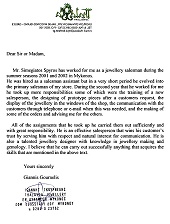 Before writing a character reference letter you must determine what is involved in doing so. There are key points that need to be implemented to write a successful character response letter. Whether the character response letter is for a job, academic program or a court-related letter there are fundamental tips to follow to ensure a successful response.
Before writing a character reference letter you must determine what is involved in doing so. There are key points that need to be implemented to write a successful character response letter. Whether the character response letter is for a job, academic program or a court-related letter there are fundamental tips to follow to ensure a successful response.
Here are six facts needed to write a successful character response letter regardless of its purpose:
1. Describe how you know the person you are backing. Including details about your relationship to one another gives the reader an idea of the person’s character. Doing this in several sentences is acceptable. An example of this would be: John Smith and I have been friends for 10 years. We met through mutual friends and had an instant chemistry. He is very responsible and reliable as a friend and also as a worker. He is loyal to all who know him and takes his responsibilities very seriously.
2. When writing your letter use a three-part format. The first paragraph can be an introduction where the reader learns about you, the writer. The second paragraph is the body of the letter where your message is expressed to the reader. The third paragraph is the conclusion that reinforces the beliefs you expressed in the body of the letter. The body of the letter should be a narrative that accounts for 1 to 3 specific incidents regarding the person you are backing. Always demonstrate their positive attributes, never include negative traits.
3. The tone of the entire character reference letter must stay positive. Including negative attributes will only yield negative results.
4. Only include the basics in your letter. Keep the character reference letter short. Making the letter too long will result in the reader losing interest. Their time is valuable, so convey your thoughts in a thoughtful and concise manner. One page in length is preferable.
5. Make sure the tone of the letter addresses the context. For example, if it is for a job discuss that jobs particular industry.
6. Lastly, a final edit is critical. You should always check for grammar, spelling and punctuation mistakes before sending your final draft.
Here are some examples of positive attributes commonly used in character reference letters:
• Ambitious, Anxious to learn and grow
• Charming and has a sense of humor
• Committed and responsible
• Loyal and devoted
• Considerate, caring and empathetic
• Courteous and polite
• Able to work independently but also a team player
• Detail-oriented and quality-minded
• Determined and goal-oriented
• Fair-minded, honest, trustworthy
• Follows instructions easily
• Generous, giving and helpful
• Good leader and mature for their age
• Good listener and good communicator
• Hardworking and diligent
• Intelligent and a quick learner
• Organized and a multitasker
• Patient, level-headed and always welcomes feedback
• People oriented and easygoing
Following these tips will help you write a successful character reference letter regardless of what its purpose may be.